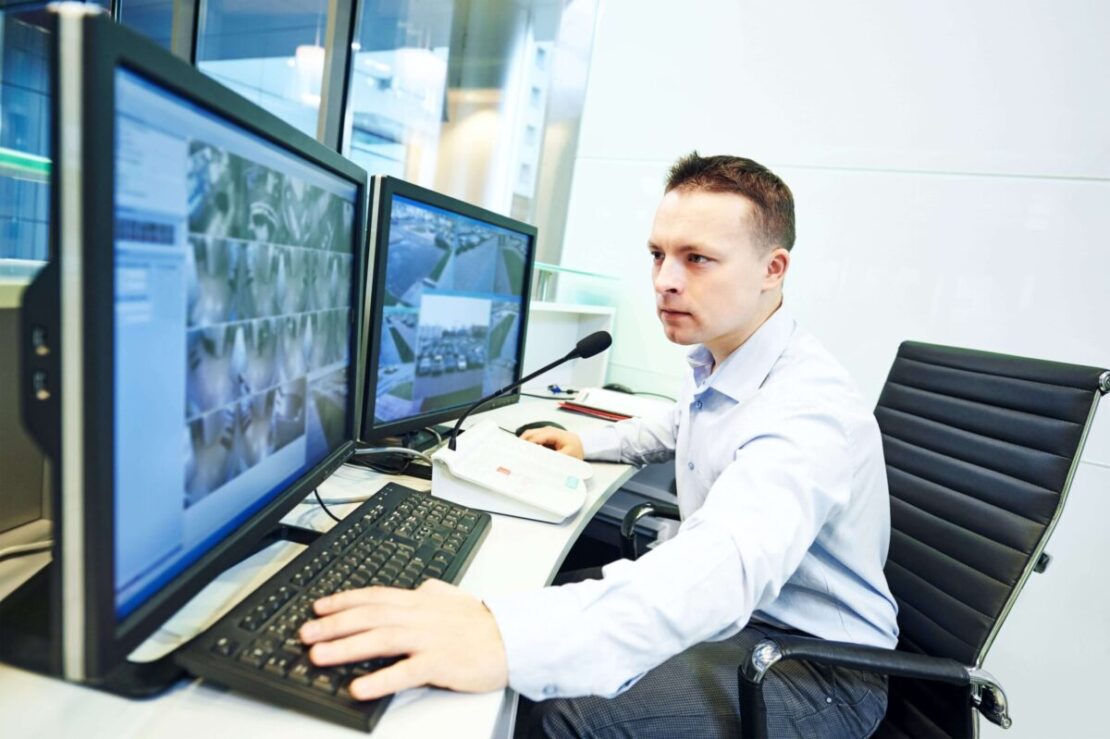
Considering the nature of warehouse operations, ensuring security and safety of goods and inventory is paramount. These operations are the backbone of the UK’s supply chain and, as a result, are often targeted by criminals.
This article highlights how CCTV monitoring improves warehouse security, illustrating how it works and the benefits on offer.
Table of contents
What is CCTV monitoring?
CCTV monitoring involves using surveillance cameras and detection technology to spot and deal with threats as they occur. Cameras are fitted with sensors and detection devices that when triggered, send an alert to an offsite team to review.
If a threat is spotted, an immediate response to the incident is actioned. The benefits of remote CCTV monitoring are vast. For instance, implementing a monitored CCTV system is approximately 80% less expensive than hiring security guards.
Related reading: What is CCTV monitoring?
How does CCTV monitoring improve warehouse security?
In this section of our guide to how CCTV monitoring improves warehouse security, we offer insight into some of the benefits these systems offer.
These include:
- Detecting threats in real time
- Reducing the cost of security
- Protecting revenue and operations
Detecting and deterring threats in real time
Remote CCTV monitoring allows you to detect and deal with threats as they unfold.
Therefore, for warehouse operations, live CCTV monitoring offers the ability to respond instantly to break-ins, trespass, and attempted theft.
Here is a quick overview of the key components of a monitored surveillance system.
Video analytics & sensors
Advanced analytics and motion detection sensors embedded in CCTV monitoring systems enable the identification of potential threats as they arise.
This capability allows security teams to react instantly to any suspicious activities, thereby, reducing the potential for damage or loss.
Thermal security cameras
Particularly, thermal cameras significantly improve threat detection in low-light conditions.
These cameras, coupled with AI-driven video analytics can accurately identify intruders by their heat signatures, regardless of lighting conditions.
Stealth surveillance
Additionally, integrating LED illuminators improves the capability to detect intruders even in pitch-black conditions.
The benefit of using LED illuminators is that the light they emit is invisible to the intruder, meaning they are unaware of being spotted.
As a result, this means the authorities can be contacted, and the intruder apprehended, accordingly.
Audio challenge (tannoy)
Furthermore, audio intervention allows operatives to confront intruders or vandals directly, advising them to vacate the premises.
As a result, this helps reduce the potential for damage or loss.
These audio devices issue live or pre-recorded warnings to intruders, making them a highly cost-effective addition to any monitored system.
Reducing the cost of security
Implementing CCTV monitoring can lead to substantial cost savings for warehouses. By reducing the reliance on security guards, warehouses can lower operational costs without compromising on security.
Although the impact of crime can be substantial, threats often occur infrequently.
Why pay to have guards on site 24/7 or after hours, when a fully monitored surveillance system will offer you detection, deterrent, and fast responses where required, at a fraction of the cost?
The cost of employing guards vs. CCTV monitoring
Now, let’s take a look at two different scenarios to compare the costs of security guards and CCTV monitoring:
Scenario 1: Two on-site guards vs. CCTV monitoring
In this case, the business employees guards to monitor the site overnight and as you can see the costs are significant.
- Guards: £80,000 annually
- Installation costs: £45,000 (initial)
- Camera monitoring: £4,000 to £6,000 per year
In Scenario 1, while employing two on-site guards incurs a significant yearly expense, the cumulative costs of installation and ongoing monitoring for CCTV monitoring are notably lower.
Despite ongoing monitoring fees, CCTV emerges as the more cost-effective option.
In this instance, the cost saving CCTV monitoring offers are £29-£31,000 in the first year, and £74-£76,000 per annum from year two.
Scenario 2: One security guard vs. CCTV monitoring
In this scenario, one security guard is employed out of hours to patrol the site and watch over the CCTV footage.
- Security guard: £35,000 annually
- Cost of installation: £25,000 (initial)
- Ongoing monitoring: £3,000 to £4,000 per year
Despite the lower annual expense of one security guard, the cumulative costs of CCTV monitoring remain competitive and often more favourable over time.
In this instance, the cost saving CCTV monitoring offers are £6-£7,000 in the first year and £31-£32,000 per annum after year two.
Summary
Choosing CCTV monitoring over security guards proves to be financially prudent in both scenarios. Despite initial investments and ongoing monitoring fees, the long-term cost-effectiveness of CCTV monitoring makes it a compelling choice for businesses seeking robust security measures within budget constraints.
Protecting revenue and operations
CCTV monitoring extends beyond just deterring theft or vandalism.
It plays a key role in protecting a warehouse’s revenue and operational continuity.
By ensuring the safety of goods stored within, CCTV monitoring helps to maintain the integrity of the supply chain and protects client relationships.
Using CCTV monitoring to improve warehouse security – summary
The importance of CCTV monitoring in warehouse security cannot be overstated. The ability to detect threats in real-time, along with the cost benefits, makes CCTV monitoring an essential tool for protecting warehouses.
Additionally, the protection it offers to both revenue and operations further highlights the vast benefits these solutions provide. By deploying these systems, operators of warehouses and those in charge of security can ensure a secure and efficient environment that supports their operational objectives.
Related articles
Article FAQs
Looking to learn a little more?
Here are a handful of questions you may have after reading this article.
Yes absolutely, in most cases they can.
CCTV remote monitoring systems can seamlessly integrate with existing security devices through network connections.
Furthermore, they can complement alarm systems and access control by providing visual verification of alarms and managing entry points via connected software.
For vast, open spaces, PTZ (Pan-Tilt-Zoom) cameras are ideal as they cover large areas and can zoom in on details. Furthermore, they track the intruder around the site and protect your site’s perimeter.
In contrast, fixed cameras like bullets or turrets are suitable for smaller, confined spaces. As a result. this is the right call for spaces needing constant monitoring.
Furthermore, thermal cameras are recommended for low-light conditions to detect unauthorised entry based on heat signatures.
The cost varies based on factors like warehouse size, the number of cameras needed, and the type of technology used (e.g., standard definition vs. high definition, infrared capabilities).
In addition to hardware, there is a monthly monitoring fee.
It’s very hard to say without surveying your site or having a full understanding of your requirements.
However, it is typical that after the initial cost of installation, the ongoing monitoring fee is around 75% less than the cost of employing security guards.
As a result, the systems are perfect for warehouses that may be relying on expensive security guards. On the other hand, CCTV monitoring is the perfect solution for small warehouse operations that are looking for a cost-effective 24/7 security solution.
Yes, it’s crucial to comply with privacy laws and regulations. For example, employees and visitors should be informed about the surveillance through visible signage.


